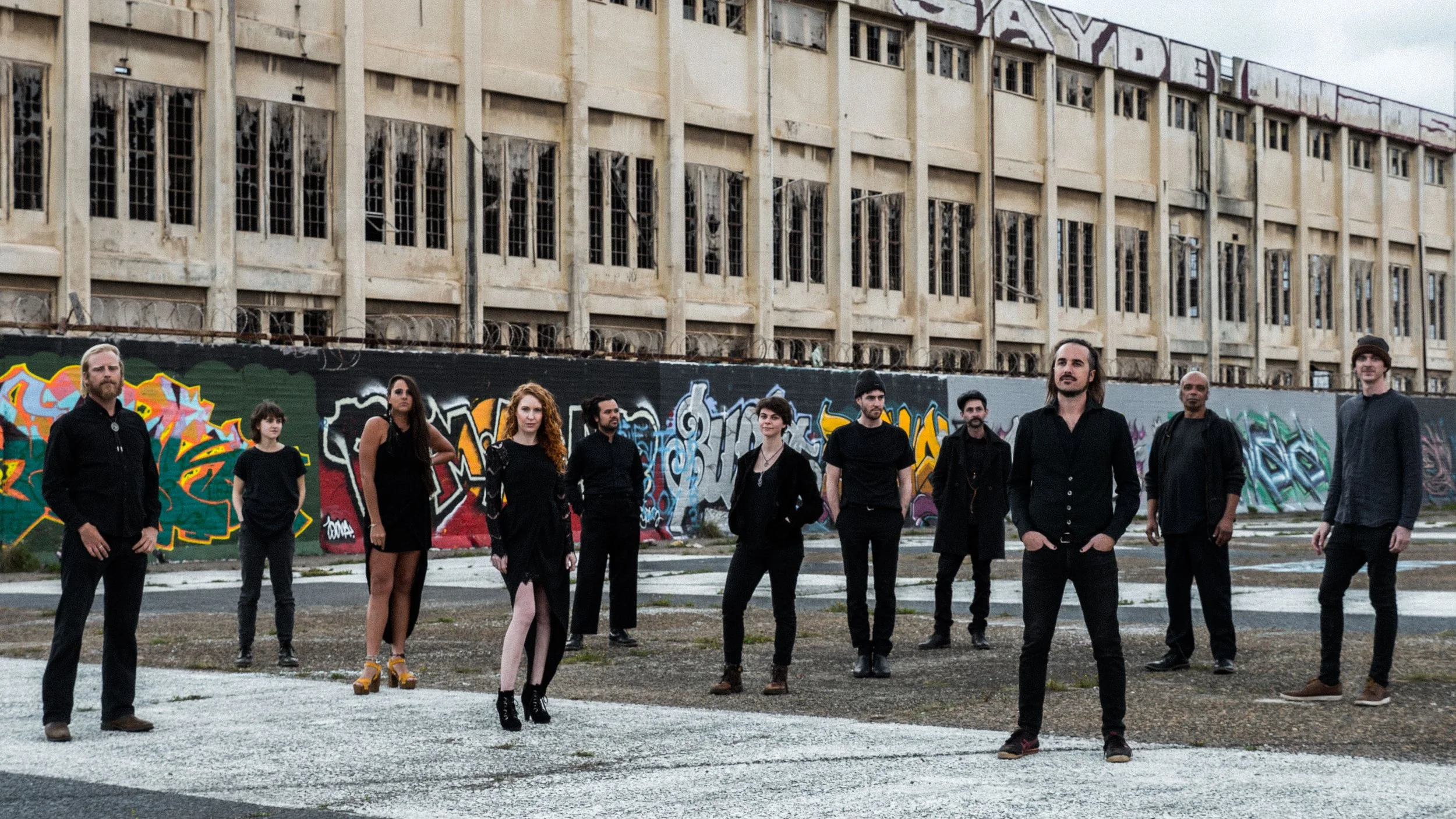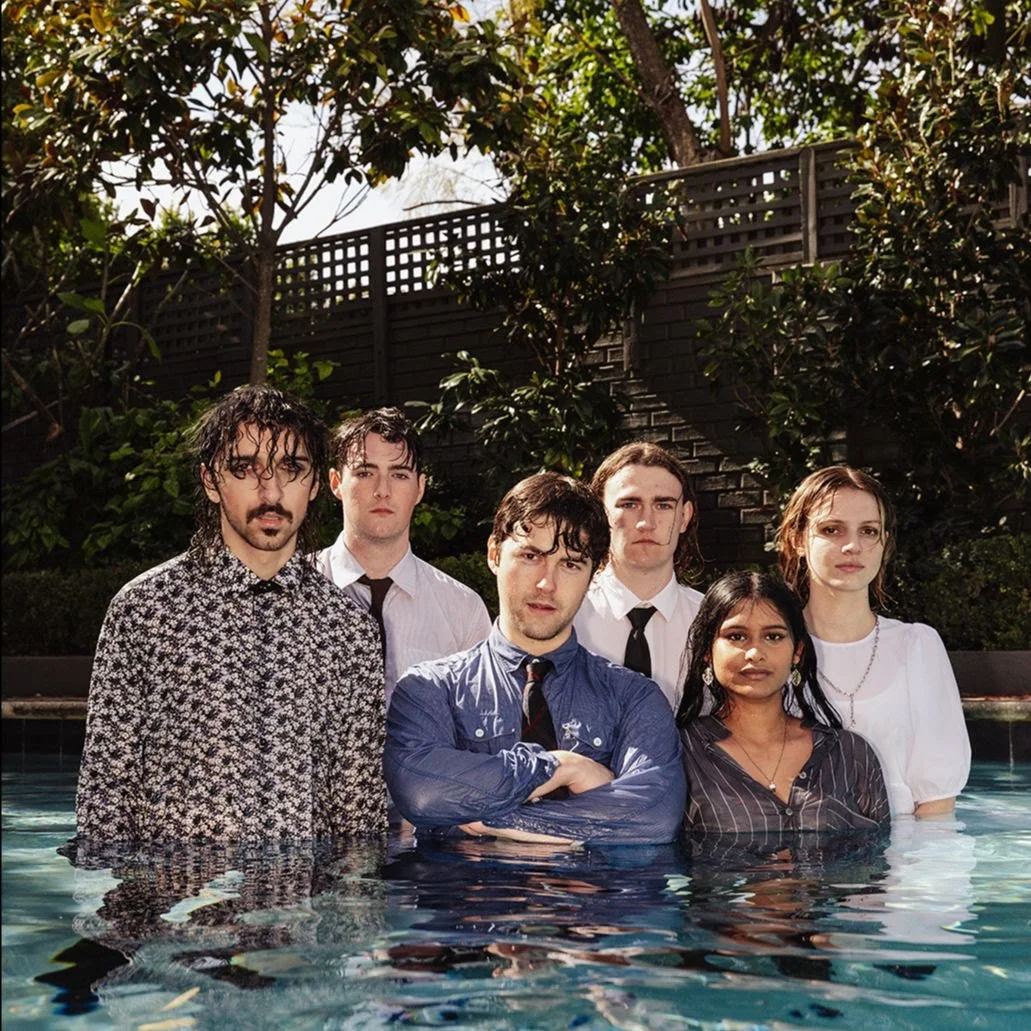Selfless Orchestra on ambitious new album Terra Nullius: "It isn’t just a historical term, it’s a living wound."
In 2020, Selfless Orchestra, a collective of WA musicians, artists, and filmmakers, made waves with their debut album Great Barrier, an arresting post-rock elegy for the dying reef that fused instrumental music and filmmaking into one immersive experience of protest. Their follow-up, Terra Nullius, builds on that ambition with something even more expansive and profoundly human.
Described as their “most urgent work to date,” listening to Terra Nullius feels like being invited into a cinematic rage against the machine: a sprawling, emotionally charged journey that interrogates Australia’s colonial foundations and the silences that still shape our collective identity. The album is alive with experimental twists and turns, both in sound and in emotion.
To celebrate the album’s release, we spoke with guitarist, songwriter, and sound designer Steven Alyian about the record’s origins, its live-to-tape process, and how making music became an act of truth-telling and connection.
Can you tell us a bit about your journey in making this album?
Steven Alyian: The seed for Terra Nullius was planted years ago, out on Country in the Goldfields, sitting around the fire with Elders who were speaking about the struggles their communities still face. It was part of a peaceful protest I joined, which was honestly one of the best things I’ve done in my life — walking across the desert on foot, setting up camp each night and talking to the old people by the fire.
One night, we listened to Uncle Geoffrey Stokes, whose perspective was a chilling but honest reflection on the issues First Nations people were facing in those regions. He remarked how all their trauma, all their suffering, traces back to that single declaration of “nobody’s land.” Hearing those stories, you realise that Terra Nullius isn’t just a historical term, it’s a living wound that shapes how all of us relate to the land and to each other.
From there, the project grew slowly and deliberately. Many of the first song sketches that I contributed were written on those trips on a cheap classical guitar I carried through the desert, and over time they evolved into fully realised pieces through the collective energy of everyone in Selfless Orchestra. We have played versions of these songs live for several years now and eventually recorded them all live in the studio — all in the same room, with no overdubs or mistake fixes — to capture the rawness and urgency of those songs. Each layer of sound, from strings to electronics, became part of a bigger conversation about truth, history and reconnection.
At its core, what is the album about?
Steven: At its core, Terra Nullius is about connection and disconnection. It looks at what happens when people are cut off from the land that sustains them, and how that loss ripples through culture, identity and spirit, regardless of whether you’re First Nations or from a foreign lineage living on another land. It’s also about listening — really listening — to the stories that the land and its people are still trying to tell, cutting through the noise that so often clouds these important issues.
And how did your creative approach or underlying philosophy evolve from Great Barrier this time round?
Compared to Great Barrier, this record feels more grounded and personal. Great Barrier was very much about the environment in crisis and a very particular part of the environment at that. That album came with the idea of fundraising for coral nurseries first; the band was kind of created after that. Whereas Terra Nullius was the first music we wrote as an existing entity of musicians, so it’s about the human story within the bigger crisis. The approach shifted, too. The lineup was different — different people bringing their soul and edge to the tracks compared to the first record — although there’s a core group of us that have been consistent through the whole journey. Again, we insisted on recording live, often in one take, so the imperfections and emotion stayed intact. We think that makes it feel less like a protest record and more like a conversation.
You recently did an album launch on October 19 at the historic Liberty Theatre as part of Strange Ball.
How did it feel finally sharing this record you’ve been working so hard on with a live audience?
Steven: It actually had taken us some time to finish the record and get it ready to release. We’re all very busy with different projects, causes, families, so when the opportunity came up to do something with the Strange Festival, it felt right because I knew they could get Liberty Cinema and I always wanted Selfless to do a local show there. I felt like I knew we would play there one day — I knew the space from a couple of illegal parties many years ago!
We’re a cinematic band, so to do the show in an abandoned cinema was kind of perfect. It was incredible but also surreal, speaking to the decay and history of the city. This is kind of only phase one, however, as we always destined this album to be part of a bigger project, and we are planning to re-launch the album — in a way — in early 2026 with a collaboration with dancers and First Nations musicians, which we are plotting out now. That’s when I think this music is really going to evolve to its final form.
What are your thoughts about Strange Ball?
Steven: Huge kudos to the team at Strange. The access they’ve been able to get in Perth city for unique and experimental art to find new audiences must be commended. So the Ball wasn’t just a gig — it was an immersive night of art, music and performance that really encouraged people to engage on a deeper level. The antidote to our distracted society is immersion in creativity.
The curation was bold and unpredictable, which we thought was a great atmosphere. These types of gigs remind us of the kind of creative ecosystem we are part of — so inspiring. Perth really does have a lot going on, and it’s good to celebrate that. Putting on these kinds of shows is difficult, but so worth it for the memories, friendships and collaborations that come from the community that comes to these things.
The blend of strings, guitars, didgeridoo, authentic field recordings and voices of those impacted by displacement makes the soundscape of this album feel so inventive.
What were the sonic influences that played a role in the production of this record?
Steven: I can’t speak for the whole band too deeply on this one, but it’s something I don’t really think about all that much now. The songs I wrote on piano and guitar really just came from connecting to an emotion or feeling and using those raw instruments to transmute that, so it’s not so much sonic influences rather than emotional influences and just grabbing whatever musical tool we had nearby and going for it.
Especially with the songs I wrote the initial parts for out on Country, a bunch were written on this nearly broken classical guitar that I had purchased while travelling in South America. I bought it from a small shop in a town in the Amazon — it cost me like 40 soles, maybe 15 bucks — and the neck is really bent, but for some reason its humility is a nice conduit for these raw songs. I took it out to the desert because it was the type of thing I wouldn’t mind if it broke or got too hot or dusty. Funnily enough, I still have it! I’d probably be sad to lose it now.
The voice recordings are things I recorded myself with a camera or Zoom recorder when I was out on these trips. I do a lot of soundtrack composing and sound design work these days, which definitely has an influence on how I put these songs together, and I also do a lot of ambient live music in the form of sound therapy or sound baths. I love creating those deep sonic spaces for reflection and I definitely incorporate a lot of those shades of stillness and harmonic drones into how the structured musical moments are stitched together.
The album was recorded live at Loop Studios, and also in an abandoned train station.
What was that like? Did you face any challenges during this process?
Steven: Recording live in that old train station was wild. We did that song a year before the others on the record, just taking a chance opportunity to travel out to Coolgardie with Drew Goddard from Karnivool (who played drums on the song and guitar on our first album), who had access to the place and works with the First Nations mob out that way.
The place had this huge natural reverb that instantly gave the music a sense of space and history. You could almost feel the ghosts of the past in there, which really suited the themes of the album. Making that kind of music inside this colonial dinosaur of a building summed up everything we were responding to on the album. We wanted that raw, unfiltered energy that comes from musicians responding to each other in real time and even thinking about the environment we were in.
The following year, we had finished the other arrangements and went to Loop, which is kind of the opposite of the train station — a clean, clear studio — so that was actually kind of easy. We bashed out pretty much the entirety of the album in just one day there. Doing live takes makes you not mess around and just get it done, get it right, less room for choices or complexities. We set up on a Friday night, came in at 10 a.m. on Saturday and were done by 5 p.m. Great-sounding room and nice to record in there together, but in an ideal world, we would have done each song in a different rotting colonial building somewhere in Australia, but it would have been a herculean effort!
The record takes on weighty and deeply socially resonant themes: from the Maralinga nuclear tests to the struggles of refugees at Woomera detention centre, and the erasure of ancient Aboriginal rock art.
What was it like, emotionally and creatively, to turn those continuing struggles into something powerful through music?
Steven: It just felt necessary. A lot of us in the band do a lot of activism. We are involved in all sorts of protests, communities and outreach programs, so this feels like a poetic processing of what we are going through in the other parts of our lives. It helps us understand what we are experiencing or being exposed to, in a way.
I think the instrumental format also allows us to process more on an emotional level rather than try to over-intellectualise it or diminish or distance ourselves from the impact these issues are having on us, especially when it’s coming from our own lived experience or from shared conversation with people who actually lived it. For example, I’ve been to Murujuga multiple times, I’ve met families of those affected by Maralinga. Those experiences get inside you when they are tangible encounters with suffering and destruction. The music helps us deal with that.
What was your favourite part about making this album?
Steven: I really liked what we did out in Coolgardie when we recorded “Yeelirrie,” the first song we put down for the album. A great moment was when the local First Nations kids down the road swung by the train station to hang out while we recorded the song. We would show them our guitar effects pedals and jam on the drums in between the takes and blow their minds — it was super cute.
However, I think my favourite moment may still be coming. When we made our first record we created an ethos for our music to have some tangible impact upon the issue we are creating music about. So with Great Barrier this was easy — we donated money to coral nurseries and to protest groups standing up for that ecological issue.
For this record, it’s a much bigger issue we are tackling, so it’s not going to be as simple as donating money, which is where this dance collaboration comes in. We are going to make a platform for First Nations artists using this music, giving them a voice and opportunity within the explored themes that we are transmuting, and this feels like more of a resolution or end point to validate the original manifesto of the project — don’t just write music about the issue but actually empower the audience to feel like they’ve contributed to making change or making that problem easier to solve. Even if it’s just a small gesture, I think that’s important. So once we achieve that, then I think I’ll have my true favourite moment.
Given the deeply personal and historical nature of the themes, what kind of impact do you hope Terra Nullius will have on listeners?
Steven: I hope it encourages people to listen more deeply, to the stories that don’t always make the surface, and to the Country itself. So much of what’s happened in Australia has been silenced or simplified, and part of what we wanted to do with Terra Nullius was to make space for reflection. Not to preach or point fingers, but to invite people to feel something real and maybe see things differently, like we have through some experiences that we’ve been fortunate to have.
I want audiences to feel how this whitefella felt when he went out to the desert for a couple of weeks and walked and camped on the land, realising how little I needed to be happy, how perfectly present I felt out there. How special that is.
If the record sparks curiosity, empathy, or even just a moment of quiet recognition about the history beneath our feet, then that’s enough. Music can reach people in ways that conversation sometimes can’t, and I think that emotional connection is where understanding really begins.
Terra Nullius is out now. You can now order the limited edition vinyl and digital album exclusively via Bandcamp. Every purchase directly supports the artists and the independent label behind this release.






